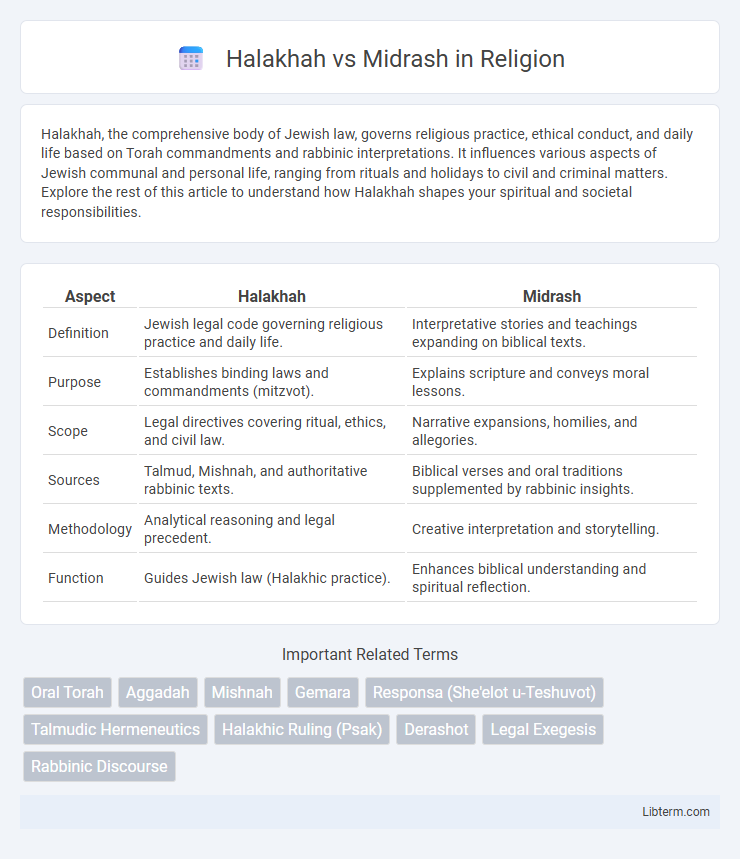Halakhah, the comprehensive body of Jewish law, governs religious practice, ethical conduct, and daily life based on Torah commandments and rabbinic interpretations. It influences various aspects of Jewish communal and personal life, ranging from rituals and holidays to civil and criminal matters. Explore the rest of this article to understand how Halakhah shapes your spiritual and societal responsibilities.
Table of Comparison
| Aspect | Halakhah | Midrash |
|---|---|---|
| Definition | Jewish legal code governing religious practice and daily life. | Interpretative stories and teachings expanding on biblical texts. |
| Purpose | Establishes binding laws and commandments (mitzvot). | Explains scripture and conveys moral lessons. |
| Scope | Legal directives covering ritual, ethics, and civil law. | Narrative expansions, homilies, and allegories. |
| Sources | Talmud, Mishnah, and authoritative rabbinic texts. | Biblical verses and oral traditions supplemented by rabbinic insights. |
| Methodology | Analytical reasoning and legal precedent. | Creative interpretation and storytelling. |
| Function | Guides Jewish law (Halakhic practice). | Enhances biblical understanding and spiritual reflection. |
Defining Halakhah: The Jewish Legal Framework
Halakhah represents the comprehensive Jewish legal framework derived from the Torah, Talmud, and subsequent rabbinic interpretations, guiding religious, ethical, and social conduct. It strictly codifies laws regarding rituals, dietary rules, and civil matters, serving as a binding legal code for Jewish communities. Unlike Midrash, which primarily offers homiletic and interpretative narratives to explain biblical texts, Halakhah functions as prescriptive law governing daily life and communal practice.
Understanding Midrash: Interpretative Traditions
Midrash represents a diverse body of Jewish interpretative traditions that explore deeper meanings and ethical lessons within the Hebrew Bible, often filling gaps left by the straightforward legalistic approach of Halakhah. Unlike Halakhah, which focuses on codified Jewish law and practical application, Midrash employs storytelling, allegory, and homiletic techniques to uncover spiritual insights and theological concepts. These interpretative methods enrich biblical texts by providing layered explanations that resonate with historical, cultural, and moral contexts.
Historical Origins of Halakhah and Midrash
Halakhah and Midrash both emerge from ancient Jewish textual traditions, with Halakhah representing the codified legal framework derived from the Torah and oral law, while Midrash comprises exegetical stories and interpretations that elucidate biblical narratives. Historically, Halakhah took shape through the development of the Mishnah around 200 CE, followed by the Talmud, which further systematized Jewish legal principles. Midrashic literature traces back to similar periods but emphasizes interpretive expansions found in collections like Midrash Rabbah, blending legal, ethical, and theological insights.
Core Purposes: Law vs. Interpretation
Halakhah serves as the comprehensive legal framework governing Jewish religious, ethical, and social conduct, providing concrete rules derived from Torah and rabbinic authority to guide daily life and communal practices. Midrash functions as a method of scriptural interpretation, offering narrative expansions, ethical teachings, and theological insights that explore deeper meanings and contextual nuances of biblical texts. While Halakhah establishes normative law and prescriptive duties, Midrash enriches understanding through imaginative exegesis and moral lessons, complementing the legal corpus with dynamic interpretative commentary.
Key Texts in Halakhah and Midrash
Halakhah centers on legal texts such as the Mishnah and the Talmud, which provide detailed laws and guidelines for Jewish religious practice and daily life. Midrash encompasses interpretive writings including Midrash Rabbah and Midrash Tanchuma, offering narrative expansions and ethical lessons to scriptural verses. Key texts in Halakhah codify commandments and rituals, while Midrashic texts illuminate biblical stories through allegory and moral insight.
Methods of Derivation and Analysis
Halakhah relies on legal codes and authoritative texts, using strict hermeneutic principles such as the 13 rules of Rabbi Ishmael to derive binding Jewish law from the Torah. Midrash employs interpretive and homiletic methods, emphasizing narrative expansion, allegory, and theological insights to elucidate biblical verses and uncover deeper meanings. While Halakhah focuses on practical application and normative rulings, Midrash prioritizes exegetical creativity and ethical lessons through imaginative textual analysis.
Authority and Application in Jewish Life
Halakhah serves as the authoritative legal framework governing Jewish religious, ethical, and social practices, derived from the Torah, Talmud, and rabbinic enactments, dictating daily rituals, dietary laws, and moral conduct. Midrash functions as an exegetical method interpreting biblical texts through narrative expansions and allegorical stories, enriching theological understanding and ethical teachings but lacking the binding legal authority of Halakhah. In Jewish life, Halakhah shapes concrete legal obligations and communal norms, while Midrash inspires spiritual reflection and deepens scriptural engagement without prescribing enforceable rules.
Interaction and Overlap Between Halakhah and Midrash
Halakhah and Midrash interact significantly in Jewish tradition, where Halakhah represents the legal framework and Midrash provides interpretative narratives that illuminate scriptural texts. The overlap occurs as Midrashic stories and explanations often underpin legal rulings, informing and shaping Halakhic decisions through exegetical insights. This dynamic relationship allows Midrash to add depth and context, enhancing the understanding and application of Halakhah within Jewish law.
Contemporary Relevance and Challenges
Halakhah, as Jewish law governing daily life, remains central to contemporary religious practice and legal decision-making, while Midrash, comprising interpretive narratives and exegesis, enriches ethical understanding and cultural identity. Modern challenges include interpreting Halakhah in light of technological advances and evolving social norms, and balancing Midrashic allegory with literal scriptural applications. Both frameworks face ongoing debates regarding adaptation, authority, and relevance within diverse Jewish communities worldwide.
Summary: Distinctions and Synergy
Halakhah represents the legal framework of Jewish law derived from the Torah, Talmud, and rabbinic interpretations, guiding daily religious practices and ethical conduct. Midrash encompasses exegetical narratives and homiletic teachings that explore biblical texts with allegorical and interpretive insights, often addressing moral lessons and theological questions. The synergy between Halakhah and Midrash lies in their complementary roles: Halakhah establishes normative law, while Midrash enriches scriptural understanding, allowing dynamic interaction between legal rigor and interpretive creativity within Jewish tradition.
Halakhah Infographic

 libterm.com
libterm.com